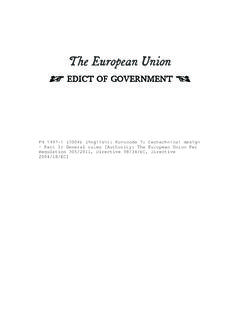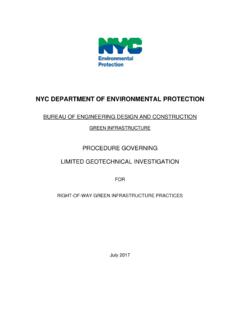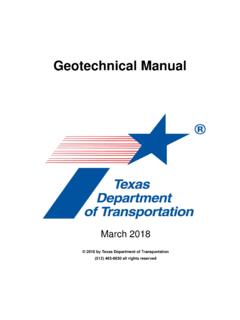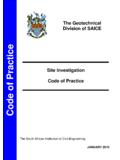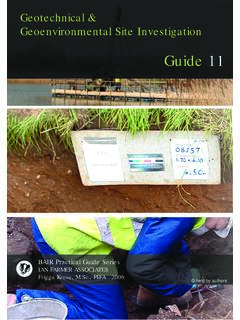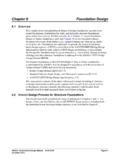Transcription of EN 1997-1: Eurocode 7: Geotechnical design - Part 1 ...
1 The European UnionIn order to promote public education and public safety, equal justice for all, a better informed citizenry, the rule of law, world trade and world peace, this legal document is hereby made available on a noncommercial basis, as it is the right of all humans to know and speak the laws that govern them. EDICT OF GOVERNMENT EN 1997-1 (2004) (English): Eurocode 7: Geotechnical design - Part 1: General rules [Authority: The European Union PerRegulation 305/2011, Directive 98/34/EC, Directive2004/18/EC]EUROPEAN STANDARD EN 1997 .. 1 NORME EUROPEENNE EUROpAISCHE NORM November 2004 ICS Supersedes ENV 1997-1'1994 English version Eurocode 7: Geotechnical design -Part 1: General rules Eurocode 7: Calcul geotechnique - Partie 1: Regles generales Eurocode 7: Entwurf, Berechnung und Bemessung in der Geotechnik Teil1 Allgemeine Regeln This European Standard was approved by CEN on 23 April 2004. CEI\J members are bound to comply with the CEN/CENELEC Internal Regulations which stipulate the conditions for giving this European Standard the status of a national standard without alteration.
2 Up-to-date lists and bibliographical references concerning such national standards may be obtained on application to the Secretariat or to any CEN member. This European Standard exists in three official versions (English, French, German). A version in other language made by translation under the responsibility of a CEN member into its own language and notified to the Central C:ol~r",l""'ri,,,t has the same status as the official versions. CEN members are the national standards bodies of Austria, Belgium, Cyprus, Czech Republic, Denmark, Estonia, Finland, France, Germany, Greece, Hungary, Iceland, Ireland, Italy, Latvia, Lithuania, Luxembourg, Malta, Netherlands, Norway, Poland, Portugal, Slovakia, Slovenia, Spain, Sweden, Switzerland and United Kingdom. EUROPEAl\ COMMITTEE FOR STANDARDIZATION COMITE EUROPEEN DE NORMALISATION EUROr)\ISCHES KOMITEE :'\ORMU".'G Management Centre: rue de Stassart, 36 B-1050 Brussels 2004 CEN All rights of exploitation in any form and by any means reserved worldwide for CEN national Members.
3 Ref. No. EN 1997-1: 2004: E BS EN 1997-1: 2004 EN 1997-1: 2004 Contents Foreword .. 5 Section 1 General .. 9 Scope .. 9 Normative references .. 10 Assumptions .. 11 Distinction between Principles and Application Rules .. 11 Definitions .. 12 Symbols .. 13 Section 2 Basis of Geotechnical design .. 19 design requirements .. 19 design situations .. 21 Durability .. 22 Geotechnical design by calculation .. 23 design by prescriptive measures .. 35 Load tests and tests on experimental models .. 36 Observational method .. 36 Geotechnical design Report .. 36 Section 3 Geotechnical data .. 38 General .. 38 Geotechnical investigations .. 38 Evaluation of Geotechnical parameters .. 39 Ground Investigation Report .. 47 Section 4 Supervision of construction, monitoring and maintenance .. 49 General .. 49 Supervision .. 49 Checking ground conditions .. 51 Checking construction .. 52 Monitoring .. 53 Maintenance .. 54 Section 5 Fill, dewatering, ground improvement and reinforcement.
4 55 General .. 55 Fundamental requirements .. 55 Fill construction .. 55 Dewatering .. 59 Ground improvement and .. 60 Section 6 Spread foundations .. 61 General .. 61 Limit states .. 61 Actions and design situations .. 61 design and construction considerations .. 61 Ultimate limit state design .. 62 Serviceability limit state design .. 65 Foundations on rock; additional design considerations .. 67 Structural design of spread foundations .. 68 Preparation of the subsoil .. 68 Section 7 Pile foundations .. 70 General .. 70 Limit states .. 70 Actions and design situations .. 70 2 BS EN 1997-1: 2004 EN 1997-1: 2004 design methods and design considerations .. 72 Pile load tests .. 74 Axially loaded piles .. 76 Transversely loaded piles .. 86 Structural design of piles .. 88 Supervision of construction .. 88 Section 8 Anchorages .. 91 General .. 91 Limit states .. 92 design situations and actions .. 92 design and construction considerations.
5 93 Ultimate limit state design .. 94 Serviceability limit state design .. 95 Suitability tests .. 95 Acceptance tests .. 96 Supervision and monitoring .. 96 Section 9 Retaining structures .. 97 General .. 97 Limit states .. 97 Actions, geometrical data and design situations .. 98 design and construction considerations .. 101 Determination of earth pressures .. 102 Water pressures .. 105 Ultimate limit state design .. 105 Serviceability limit state design .. 109 Section 10 Hydraulic failure .. 111 GeneraL .. 111 Failure by uplift .. 112 Failure by heave .. 114 Internal erosion .. 114 Failure by piping .. 115 Section 11 Overall stability .. 117 GeneraL .. 117 Limit states .. 117 Actions and design situations .. " .. 117 design and construction considerations .. 118 Ultimate limit state design .. 119 Serviceability limit state design .. 121 Monitoring .. 121 Section 12 Enlbankments .. 123 General.. 123 Limit states .. 123 Actions and design situations.
6 123 design and construction considerations .. 124 Ultimate limit state design .. 125 Serviceability limit state design .. 126 Supervision and monitoring .. 126 Annex A (normative) Partial and correlation factors for ultimate limit states and recommended values .. 128 Annex B (informative) Background information on partial factors for design Approaches 1, 2 and 3 .. 138 Annex C (informative) Sample procedures to determine limit values of earth pressures on vertical walls .. 141 Annex 0 (informative) A sample analytical method for bearing resistance calculation .. 157 3 BS EN 1997-1: 2004 EN 1997-1: 2004 Annex E (informative) A sample semi-empirical method for bearing resistance estimation .. 160 Annex F (informative) Sample methods for settlement evaluation .. 161 Annex G (informative) A sample method for deriving presumed bearing resistance for spread foundations on rock .. 163 Annex H (informative) Limiting values of structural deformation and foundation movement .. 165 Annex J (informative) Checklist for construction supervision and performance monitoring.
7 167 4 BS EN 1997-1: 2004 EN 1997-1: 2004 Foreword Trlis document (EN 1997-1) has been prepared by Technical Committee CENITC250 "Structural Eurocodes", the secretariat of which is held by BSI. CEN/TC 250 is responsible for all Structural Eurocodes. Trlis European Standard shall be given the status of a national standard, either by publication of an identical text, or by endorsement, at the latest by May 2005 and conflicting national standards shall be withdrawn by March 2010. This document supersedes ENV 1997-1: 1994. According to the CEN/CENELEC Internal Regulations, the national standards organizations of the following countries are bound to implement this European Standard: Austria, Belgium, Cyprus, Czech Republic, Denmark, Estonia, Finland, France, Germany, Greece, Hungary, Iceland, Ireland, Italy, Latvia, Lithuania, Luxembourg, Malta, Netherlands, Norway, Poland, Portugal, Slovakia, Slovenia, Spain, Sweden, Switzerland and United Kingdom. Background to the Eurocode programme In 1975, the Commission of the European Community decided on an action programme in the field of construction, based on article 95 of the Treaty.
8 The objective of the programme was the elimination of technical obstacles to trade and the harmonisation of technical specifications. Within this action programme, the Commission took the initiative to establish a set of harmonised technical rules for the design of construction works which, in a first stage, would serve as an alternative to the national rules in force in the Member States and, ultimately, would replace them. For fifteen years, the Commission, with the help of a Steering Committee with Representatives of Member States, conducted the development of the Eurocodes programme, which led to the first generation of European codes in the 1980s. In 1989, the Commission and the Member States of the EU and EFTA decided, on the basis of an agreement1 between the Commission and CEN, to transfer the preparation and the publication of the Eurocodes to CEN through a series of Mandates, in order to provide them with a future status of European Standard (EN). This links de facto the Eurocodes with the provisions of all the Council's Directives and/or Commissions Decisions dealing with European standards ( the Council Directive 89/1 06/EEC on construction products - CPD - and Council Directives 93/37/EEC, 92/50/EEC and 89/440/EEC on public works and services and equivalent EFTA Directives initiated in pursuit of setting up the internal market).
9 The Structural Eurocode programme comprises the following standards generally consisting of a number of Parts: EN 1990 Eurocode : Basis of Structu ral design EN 1991 Eurocode 1: Actions on structures EN 1992 Eurocode 2: design of concrete structures EN 1993 Eurocode 3: design of steel structures 1 Agreement between the Commission of the European Communities and the European Committee for Standardisation (CEN) concerning the work on EUROCODES for the design of building and civil engineering works (BC/CEN/03/89) . 5 BS EN 1997-1: 2004 EN 1997-1: 2004 6 EN 1994 Eurocode 4: design of composite steel and concrete structures EN 1995 Eurocode 5: design of timber structures EN 1996 Eurocode 6: design of masonry structures EN 1997 Eurocode 7: Geotechnical design EN 1998 Eurocode 8: design of structures for earthquake resistance EN 1999 Eurocode 9: design of aluminium structures Eurocode standards recognise the responsibility of regulatory authorities in each Member State and have safeguarded their right to determine values related to regulatory safety matters at national level where these continue to vary from State to State.
10 Status and field of application of Eurocodes The Member States of the EU and EFTA recognise that Eurocodes serve as reference documents for the following purposes: -as a means to prove compliance of building and civil engineering works with tile essential requirements of Council Directive 89/1 06/EEC, particularly Essential Requirement N 1 -Mechanical resistance and stability and Essential Requirement N 2 Safety in case of fire; as a basis for specifying contracts for construction works and related engineering services; as a framework for drawing up harmonised technical specifications for construction products (ENs and ETAs) The Eurocodes, as far as they concern the construction works themselves, have a direct relationship with the Interpretative Documents2 referred to in Article 12 of the CPO, although they are of a different nature from harmonised product standards3 Therefore, technical aspects arising from the Eurocodes work need to be adequately considered by CEN Technical Committees and/or EOTA Working Groups working on product standards with a view to achieving full compatibility of these technical specifications with the Eurocodes.
